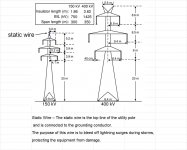Distribution typically stops at 35kv. Popular Transmission voltages are typically 69kv, 115kv, 235kv and up, but as I said before I'm not sure about the grounding.
Well given 100MW and probably max 750A per line, we're looking at 115kV minimum with Vdrop then out of those.
Let me get into the reason I'm asking. I've come across a situation of stray voltage that doesn't have a clear cause. It's a unique geographical situation, where there is the power station along an ocean coast, and a substation 30mi away also along the coast, and a peninsula in the (electrolytic) water between, with the property dead center between the two watersheds of that peninsula.
We're not sure if the stray voltage could be coming from local distribution lines (with the distribution fuse/neutral pulled over 1km away they still have stray voltage on an otherwise fairly isolated piece of grid) or objectionable grounding current from the transmission setup above.
If the transmission system is grounded on both ends and is running at over 100kV, that's about 4kV per mile of Vdrop. In this case, due to the peninsula and the fact the current has to go longways around the peninsula in the water, if there's a point between watersheds that's higher ohms than the rest, it could be seeing 10kV+ potential between one and the other.
I want to know if I'm totally off-base thinking this is the issue rather than a 3km distant distribution fault or objectionable ground current scenario.

